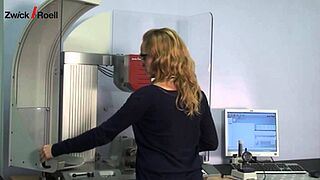ISO 8256 & ASTM D1822 Tensile Impact Tests on Plastics
Tensile impact tests provide a material property based on the impact energy, which is determined under tensile loading on standardized specimens at high strain rates. When using the same pairings of pendulum and yoke sizes, the result is a good level of reproducibility of the test results. The ISO 8256 and ASTM D1822 standards describe the tensile impact test on plastics.
Tensile impact tests are often used for very flexible film or plate specimens, as well as for soft or semi-rigid plastics, which do not result in specimen break and therefore do not provide test results using the Charpy or Izod methods (ISO 180 or ASTM D256), even for notched specimens. Testing of stiff specimens according to the definition in ISO 472 is also possible.
ISO 8256 test method
The ISO 8256 standard specifies two different test methods:
- Method A works with a test arrangement in which the specimen is fastened on one side in a defined position in a standing clamping fixture. A rigid yoke with a fixed mass is attached to the other side of the specimen. During the test, the pendulum hammer strikes the yoke, which causes it to strongly accelerate. This stretches the specimen in tensile direction until it fails.
- Method B This method is borrowed from the ASTM D1822 standard and works with the so-called specimen-in-head method. The specimen is fastened in the pendulum hammer and also provided with a defined yoke on its opposite side. Together, the specimen, yoke and pendulum form a drop weight. The yoke is stopped abruptly at the impact position, while movement of the specimen and the pendulum hammer continues and the specimen is stretched in tensile direction to the point of failure.
Normally, Method A is used in connection with the ISO 8256 standard, while tests to ASTM D1822 are always performed with the specimen-in-head method.
Tensile impact tests are also offered in the form of instrumented tests, that is, with fast force measurement. However, there is no standard for this yet.
Test requirements
Pendulum impact testers, which are specified in detail in the ISO 13802 standard, are used for conventional tensile impact tests to ISO 8256. This supports a strong level of reproducibility of tests performed using different types of test equipment and different laboratories, operators and locations.
As is the case with the Charpy impac test, the measurement principle is based on a pendulum hammer with specified energy capacity and drop height, which releases part of its kinetic energy when it penetrates the specimen. As a result, the pendulum hammer does not return to the original drop height after the impact. The measured height difference between drop height and height of rise therefore becomes a measure of the energy absorbed. By determining the drop height, the impact velocity is also defined so that the tests are performed with reproducible strain rates.
A special feature of the tensile impact test is correction of the centrifugal work absorbed by the yoke. This correction is based on the assumption of an elastic impact. In practice, however, there is an impact that has a plastic component in addition to the elastic component, so this correction remains an approximation. A direct comparison of characteristic values should therefore be carried out on an identical pairing of pendulum hammer and yoke size.
Each pendulum hammer may be used in a range of 10% to 80% of its initial potential energy. If several pendulum hammers meet this condition for testing a material, which is usually the case from the overlapping working ranges of the various pendulum hammers, the pendulum hammer with the greatest initial potential energy is used. This ensures that the reduction in speed during the impact process is minimized.
The type of measurement implies that all energy losses are attributable to the specimen and the yoke. It is therefore important to minimize, correct, or completely eliminate all external sources for error. There are strict specifications in ISO 13802, as well as checks that are part of regular calibrations, regarding friction losses that inevitably occur due to air friction and friction at the bearing points of the pendulum hammer. The correction values are measured and assigned to the respective pendulum hammer. Sufficient mass and a vibration-free installation of the pendulum impact tester on a very stable laboratory table, on a worktop bolted into a solid wall, or a masonry platform are essential for the quality of the measurement. Internal vibrations in the instrument are minimized by design. ZwickRoell uses pendulum hammers with double rods made of unidirectional carbon materials, which are very low in mass and at the same time offer optimum stiffness of the pendulum rods.
ISO 8256 defines a total of five different specimens. Types 1 and 4 are preferred for Method A, types 2 and 4 are the preferred specimens for Method B. Type 3 specimens have a parallel center part, which is square with a 10 mm edge length and is ideal for strain measurements using DIC systems. Specimen type 5 includes additional stop surfaces on the shoulder, which facilitate precise alignment and allow for form-fit force transmission with stiff materials and sufficient specimen height.

Take advantage of the leading testing software in materials testing
ZwickRoell’s testXpert testing software offers:
- Simple operation: start testing right away and be a testXpert while maintaining maximum safety.
- Reliable and efficient testing: benefit from reliable test results and maximum testing efficiency.
- Flexible integration: testXpert is the optimal solution for all of your applications and processes—simply put, a more effective workflow.
- Future-proof design: testing software for the entire life cycle, ready for your future test tasks!
